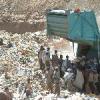
Planet Advocate Project by Michael Iyanro
 2013wastemanagementjudges 2013wastemanagementjudges Jul 9, 2013 05:49 |
Congratulations, your proposal has been named a finalist in the Climate CoLab Waste management contest. You have until July 20th to edit your proposal. The Judges suggest that you focus your edits in the areas listed below.
The Judges are aware that toilets that effectively separate urine and feces already exist, which makes it possible to convert each into a suitable fertilizer product. But is difficult to tell if the economics work, though the proposal authors seem to have at least tried a market model.
The main contribution of the proposal is that it is an implementation plan, which seeks to take an existing technology to meet a severe need for Lagos. If successful, this would solve health problems and have a modest impact on greenhouse gas emissions.
One major concern is that a cost of $5-6 per month would be prohibitive for many residents of Lagos, so the project would not be financially sustainable unless an outside revenue source, such as a large donor, were identified. It would be very helpful if the authors could provide more detail on the project's economics and identify potential sponsors who might help to defray what look to be high costs.
|
 2013wastemanagementjudges 2013wastemanagementjudges Jul 31, 2013 02:33 |
This is a very ambitious project. It is not clear if the goals can be reached, but the technology is sound and the flow of the proposal seems doable. Whether the economics are realistic will take time to tell. A major concern is that many of the references are quite old, yet the specific technology that is proposed is a fairly recent development. Could be improved with references to more recent experience with waterless toilets that separate urine and feces. The larger goals of house building are too amorphous as stated. Would recommend planning to team up with a builder and only supplying the toilet technology.
|
 Michael Oluwaseun Aug 1, 2013 04:44 | Proposal contributor
Thank you very much for this useful comments. Firstly, I will like to address certain points from the comment above.
1."The larger goals of house building are too amorphous as stated. Would recommend planning to team up with a builder and only supplying the toilet technology. "
I WILL LIKE TO REFER THE JUDGES TO THE WORK BEEN CARRIED OUT BY ONE OF THE PLANET ADVOCATE MEMBER AND IT CAN BE FOUND HERE:
(a)http://bioapplications.blogspot.com/
(b)http://bioapplications.blogspot.com/2011/11/conventional-septic-tank-versus.html
(c)http://bioapplications.blogspot.com/2009/03/harlemson-apartments-kubwa-abuja-bio.html
WE ARE PLANNING TO BRING IN ALL NECESSARY RESOURCE PERSONS INTO THE PLANET ADVOCATE CIRCLE.
2. ON THE ECONOMY, I WILL LIKE TO REFER OUR READERS TO THIS PAGES:
http://api.ning.com/files/BAcPAB7hbbgL*qSfDAFhpsJD00kKacJjBX34bT35lmzKDcDlE6xAsxW6YrRYILhUkhDkmneOJ9duT4YM2mrjcH2QMnDGIMrn/ProjectResourceSlumSanitationMar13.pdf
3." A major concern is that many of the references are quite old, yet the specific technology that is proposed is a fairly recent development."
REFERENCES:
Auborn, T., Nivala, J., Headley, T.R., van Afferden, M., Zreiqat, I., Abdallat, G., Abassi, B., Müller, R. (2012): Suitability of treatment wetlands for water-scarce countries: A case study in Jordan. In: IWA (ed): Proceedings of the 13th IWA Specialized Group Conference on
„Wetland Systems for Water Pollution Control“ - Book of Abstracts, 25-29 November 2012, Perth, WA, Australia, p.116.
Headley, T.R., Nivala, J. (2012): Are constructed wetlands an appropriate technology for hot, arid climates? In: IWA (ed): Proceedings of the 13th IWA Specialized Group Conference on „Wetland Systems for Water Pollution Control“ - Book of Abstracts, 25-29 November 2012, Perth, WA, Australia, pp.96-98.
Kadlec, R.H., Wallace, S. (2009): Treatment Wetlands. 2nd edition, CRC press, Boca Raton, FL, USA.
Mandi, L., Bouhoum, K., Ouazzani, N. (1998): Application of constructed wetlands for domestic wastewater treatment in an arid climate. Water Sci Technol 38(1), 379-387.
Masi, F., El Hamouri, B., Abdel Shafi, H., Baban, A., Ghrabi, A., Regelsberger, M. (2010): Segregated black/grey domestic wastewater treatment by Constructed Wetlands in the Mediterranean basin: the Zer0-m experience. Water Sci Technol 61(1), 97-105, Masi, F. Martinuzzi N. (2007): Constructed wetlands for the Mediterranean countries: hybrid systems for water reuse and sustainable sanitation. Desalination 215(1–3), 44-55.
The Application of Ecological Sanitation for Excreta Disposal in Dsaster Relief: Experience, Selection and Design. By Katherine Kinstedt. Institute of Wastewater Management and Water Protection. Technical University of Hamburg. April 2012. This brief (39p) overview entitled looks at the cases of Japan and New Zealand, reviews key solutions and proposes an additional longer term (relief and rehabilitation) model based on terra preta sanitation. http://www.phlush.org/emergencysan/ecosan-in-disaster-relief-copy/
“Low-Cost Sanitation Solutions A report on progress in Post-Earthquake Haiti” Andrew Larsen &Fontes Foundation.” FSM 2 Conference Durban, South Africa October 30, 2012. Project funded by a grant from the Bill & Melinda Gates Foundation. http://www.susana.org/docs_ccbk/susana_download/2-1716-a63-fsm2-larsen-salt-lake-city-usa.pdf
“Haiti recycles human waste in fight against cholera epidemic” By IsabeauDoucet. The Guardian, March 10 2013 SOIL Haiti processes feces to produce fertiliser, which is sold for crops and new forests, and to eliminate sources of disease. http://www.guardian.co.uk/world/2013/mar/10/haiti-human-waste-recycle-cholera
Emergency and Reconstruction Situations Working Group. Sustainable Sanitation Alliance. http://www.susana.org/working-groups/wg08
Ecological Sanitation Technologies
Compendium of Sanitation Systems and Technologies This concise document by Elizabeth Tilley et al. of EAWAG presents tried and tested technologies in a way that helps communities make informed decisions. Part 1 describes different system configurations for a variety of contexts. Part 2 consists of 52 illustrated Technology Information Sheets that cover advantages, disadvantages, applications and the appropriateness of the technologies required to build a comprehensive sanitation system. http://www.watersanitationhygiene.org/References/EH_KEY_REFERENCES/SANITATION/Latrine%20Design%20and%20Construction/Compendium%20of%20Sanitation%20Systems%20and%20Technologies%20(EAWAG).pdf
Sustainable Sanitation AllianceIncorporating the work of more than 190 partners, the extensive SuSanA website has case studies, videos and photos, announcements,a discussion forum, and working groups where practitioners are invited to get involved.. http://www.susana.org
SSWM ToolboxThe Sustainable Sanitation and Water Management Toolbox combines clarity on the fundamental concepts with a myriad of practical tools for both planning and process and for implementation. The interplay between concept and practice is embodied in the brilliant user interface. http://www.sswm.info/category/concept/concept-introduction
Sustainable Sanitation for the 21st CenturyEach of the 25 modules of this free 5 or 6 week course is clearly laid out like this and combines illustrated explanatory source materials and links to further reading with a slide presentation. http://www.sustainablesanitation.info
EcoSanResThis project of the Stockholm Environment Institute offers online ecosan publications, factsheets, ecosan resources focused on the developing world, EcoSanRes hosts a discussion group for ecosan professionals. To join please send an e-mail describing your interest, name and affiliation. http://www.ecosanres.org/index.htm
Technology Review of Urine Diversion Dehydration Toilets (UDDTs): Design Principles, Urine and Faeces Management. Christian Rieck, Dr. Elisabeth von Muench. Deutsche GesellschaftfürInternationaleZusammenarbeit (GIZ).Eschborn, May 2011. Available at: www.susana.org/lang-en/library?view=ccbktypeitem&type=2&id=874
The SOIL Guide to Ecological Sanitation SOIL (Sustainable Organic Integrated Livelihoods) has worked in Haiti before and since the earthquake. Their training manual can be downloaded on line following your request. http://www.oursoil.org/soils-ecosan-education-resources/
Sustainable Sanitation in Cities: A Framework for Action
ChristophLüthi, Arne Panesar, ThorstenSchütze, Anna Norström, Jennifer McConville, Jonathan Parkinson, Darren Saywell, Rahul Ingle, 2011. Superb 165 page study explains what’s wrong with contemporary urban systems and what systems that are environmentally and financially more sustainable look like.
http://www.gdrc.org/uem/usan/susana_sustainable_sanitation_in_cities_2011.pdf
Earthquakes and Sewers
The Oregon Resilience Plan: Reducing Risk and Improving Recovery for the Next Cascadia Earthquake and Tsunami.Report to the 77th Legislative Assembly
from Oregon Seismic Safety Policy Advisory Commission, February 2013
Full plan: http://www.oregon.gov/OMD/OEM/osspac/docs/Oregon_Resilience_Plan_Final.pdf
Executive Summary http://www.oregon.gov/OMD/OEM/osspac/docs/Oregon_Resilience_Plan_Executive_Summary_Final.pdf
http://en.wikipedia.org/wiki/Ecological_sanitation
|
 John Smith Aug 29, 2013 12:14 |
Howdy Mike,
I like the idea, I like the premise. I voted for this idea. I think the key is making it economical. Your goal is to take poop and turn it into fertilizer. You can use technology to do this, but at the end of the day, workers will need to be there to do maintenance, transport, troubleshooting and customer service. If they can get paid doing it - then it works.
I think of like an African port-a-potty service and fertilizer company.
|